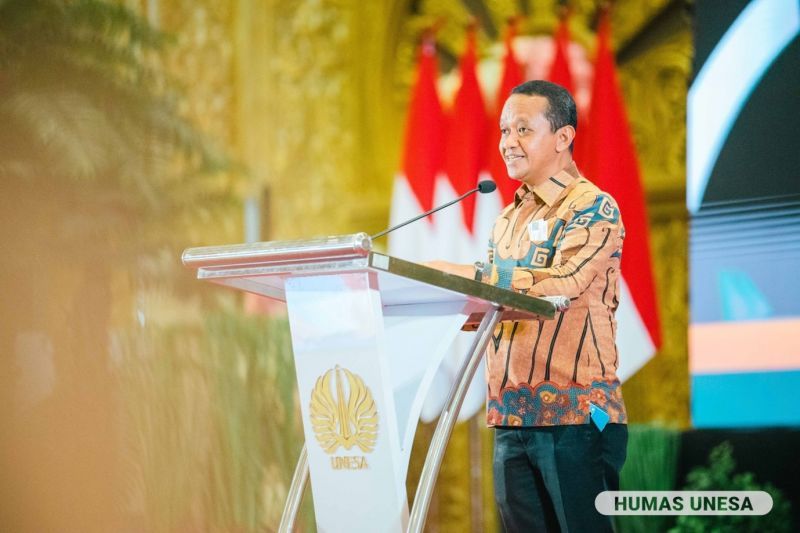
www.unesa.ac.id
Unesa.ac.id, SURABAYA–The Minister of Investment of the Republic of Indonesia, Bahlil Lahadalia, S.E., was the keynote speaker and provided reinforcement on "Inclusive and Sustainable Investment Strategies" at the XXIX Campus Convention and the XXV Annual Meeting of the Indonesian Chancellor's Forum (FRI) in Graha State University of Surabaya (UNESA) Lidah Wetan Campus II, Surabaya, on Monday, January 15 2024.
The man who is also the Head of the Investment Coordinating Board (BKPM) conveyed an overview of the dynamics of the global economy hit by instability recent events such as the Palestine-Israel conflict, Russia-Ukraine, the US-China trade war and others.
Increasingly uncertain global tensions have an impact on the domestic economy. Nevertheless, Indonesia's economic growth is still above 5% on average and inflation is still controlled at below 3%. This is one of the best economic growth of the G20 countries.
What about investment? Bahlil said that when he first joined BKPM in 2019, he couldn't believe his investment target of 795 trillion had been realized and more than 800 trillion had been realized.
In 2020 during Covid-19, his investment target was 800 trillion and was successfully realized. 825 Trillion. In 2021, the president asked for investment to increase to 900 trillion and 901 trillion was successfully realized. In 2023, the government targeted 1,400 trillion and it achieved 1,500 trillion. This means that investment growth grew above 2% of the target.
In this forum too, Bahlil revealed the latest data that since Indonesia became independent in the third quarter, investment outside Java reached 52% of the island of Java which reached 48%.
He emphasized that investment should not be Java-centric and to show quality investment, it must be shared. So then the investment pattern was changed, from the third quarter of 2020 until now, investment outside Java has been greater and reached 52% of Java at 48%.
Many investments entering Indonesia come from Singapore, China and other countries. Specifically for Singapore, not all of the money comes from the Lion Country, but most of the money of Indonesians is placed there.
Foreign Direct Investment (FDI) or the largest foreign investment in the world is the Americas and the second is Southeast Asia . In Southeast Asia, Singapore got the highest number and the second was Indonesia. "Singapore is from the financial sector, while Indonesia is from the manufacturing sector," he explained.
Related to that, the direction of the country's future policy is inclusive investment that is able to create quality jobs to provide added value through downstream instruments. Indonesia will focus on managing natural resources through creating massive added value. This is non-negotiable and must be carried out continuously.
He gave the example of the downstream program in the nickel sector, where previously the export value was only around 3.3 billion USD. In 2022, exports will reach 33.8 Billion USD. That's just one commodity. This means that downstreaming is one way to penetrate to reduce the trade balance deficit with other countries.
In the future, Indonesia will encourage the development of car batteries, which make up 40 percent of car components. The raw materials for car batteries are nickel, manganese, cobalt and lithium, three of which are found in Indonesia. Only lithium does Indonesia not have.
The largest nickel in the world with 25% of its total reserves is in Indonesia. Some time ago, his party started building its investment from upstream to downstream or from mining, smelter, precursor, cathode to battery cells. Battery cells will begin production in February in Tangerang, West Java. This will be the first car battery factory in Southeast Asia.
“That's 10 giga. So what came in was investment from LG of around 9.8 billion USD or IDR 142 trillion and CATL (Contemporary Amperex Technology Co) with an investment of around IDR 90 trillion. "Both are the biggest battery players in the world," he explained.
Apart from that, for copper, the government ordered Freeport to deposit concentrate exports and had to build a smelter to separate gold and copper. The smelter has been built for 3 billion USD in Gresik and is almost complete. Of the 3 million concentrates, it is capable of producing 60 tons of gold per year.
The downstreaming has not been completed and has not had a complete impact on the welfare of local communities. This is because policy is still centered in Jakarta or the central government. Regional companies are not yet the most important part of managing investment for downstreaming. In the future, incoming investment must collaborate with regional entrepreneurs.
For information, the XXIX Campus Convention and the XXV Annual Meeting of the Indonesian Chancellors Forum (FRI) were attended by around 800 chancellors or heads of universities throughout Indonesia. This year's forum was held at UNESA and was opened by the President of the Republic of Indonesia Joko Widodo and attended by the ranks of the Advanced Indonesia Cabinet ministers. []
***
Reporter: Rafa Afifa/Sindy Riska/Saputra
Editor: @zam Alasiah*
Photo: Public Relations Team Documentation
Share It On:






